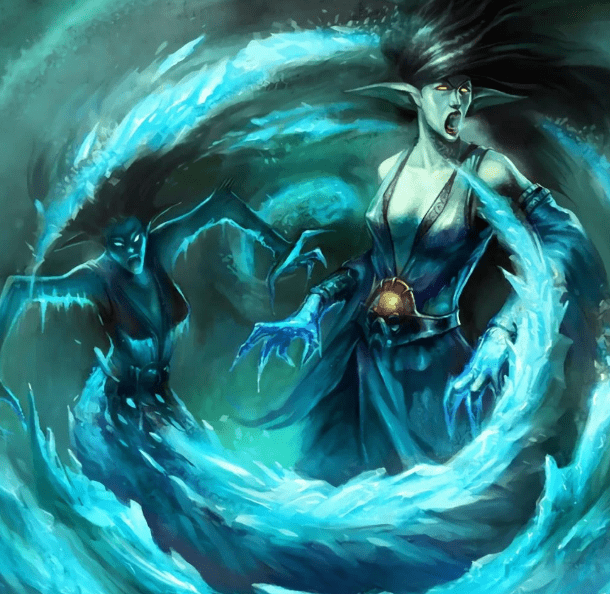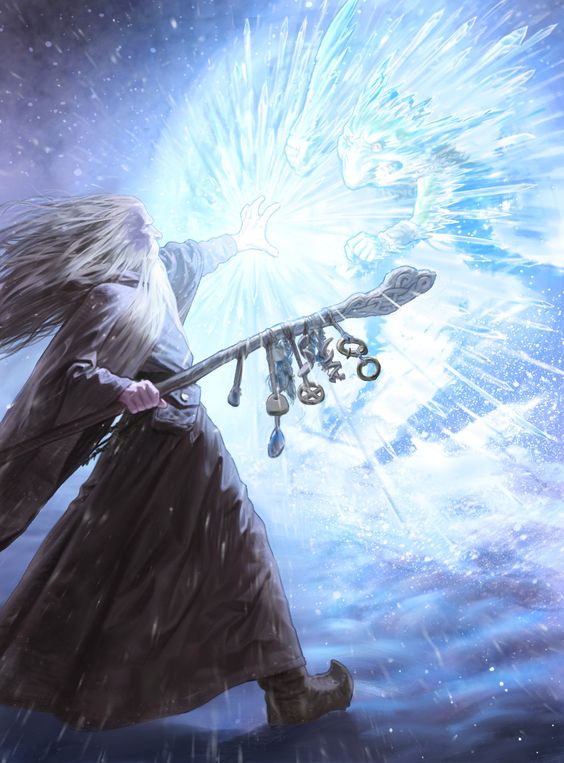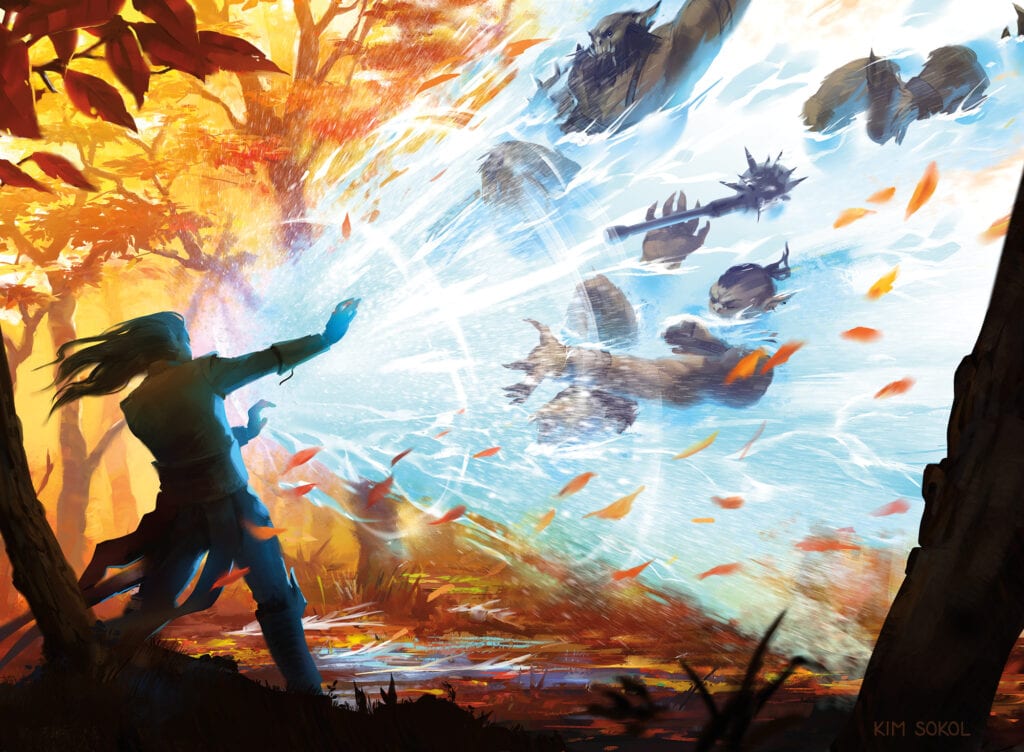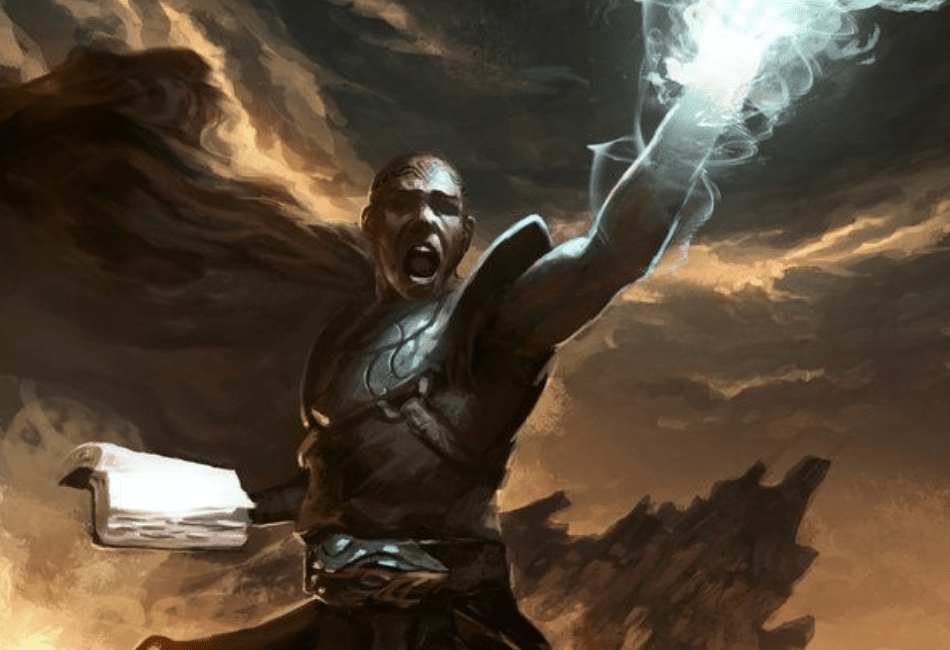Dwalin was so high above the earth as he peered through the clouds. If the fire mephits made it to the mountains, many families would die. He wasn’t sure how he should feel about that. He wasn’t even human. He was a duergar race.
And yet, there he was.
His thoughts were interrupted by a flaming cube below him. Those winged mephits had their bodies aglow with flame, flying in a tight formation. They were tightly packed in some kind of three-dimensional flying phalanx, a 30-by-30-foot cube formation.
There was no doubt in Dwalin’s mind what his weapon of choice was going to be. Welcome to a Cone of Cold 5e Guide.
Cone of Cold Spell Up Front
Cone of Cold is a mid-level damage-dealing combat spell. It does cold-based damage to anything caught within the cone.
What is the Cone of Cold Spell?

Cone of Cold is a 5th-level evocation spell. The caster creates a 60-foot cone containing a blast of cold air that emanates from their hands. Any creature caught within the cone will suffer cold-based damage. Victims caught must make a Constitution saving throw.
Those that fail the save take 8d8 cold damage (8-64 points, 32 average). Those that make the save take half damage (4-32 points, 16 average).
Any living thing killed by the cone becomes a frozen statue until it thaws.
Here are the spell’s stats as seen in Player’s Handbook (PHB) p. 224:
- Casting time: 1 action
- Range: Self 60 foot-cone
- Components: V, S, M (a small crystal or glass cone)
- Duration: Instantaneous
At Higher Levels
Damage increases for each slot level above 5th. Example:
An 11th level caster adds a 6th level spell slot to his or her Cone Of Cold. The damage is 9-72 points on a failed save.
A 13th level caster adds a 7th level spell slot to his or her Cone Of Cold. The damage is 10-80 points on a failed save.
How Do Cones Work?
Cones go in the direction chosen by the caster.
The cone’s maximum width and height equal its maximum length at the end of its range.
“A cone’s width at a given point along its length is equal to that point’s distance from the point of origin.” PHB, p. 204.
The area of effect does not include the point of origin unless the caster wishes it to.
(This means the caster doesn’t have to get worried about getting damaged by his or her own cone.) _
The end of the cone is a circle equal to the length of the cone. A Cone of Cold, for example, has a range and length of 60 feet, so the end is a circle 60 feet in diameter.
To calculate the area of effect for the purpose of killing monsters, here is a sample scenario:
Dwalin the Duergar Sorcerer with the Draconic Bloodline hides in tall grass to ambush a small army of gnolls marching in tight formation, 2 gnolls per 5-foot space, marching side-by-side. He wants to kill as many gnolls as possible with 1 Cone of Cold.

If they march in single file, Dwalin will catch and probably kill 24 gnolls with his cone if he occupies the space of the gnoll marching in the back.
60/5 = 12 spaces 12×2 = 24 gnolls
He will also kill the same amount of gnolls if they are marching in a horizontal line and he shoots his cone from 60 feet away.
Close to ideal, would be if the gnolls are marching in a 30 x 30 ft. square formation with 2 gnolls per 5 x 5 ft. space. That square formation contains 36 squares, each of the squares containing 2 gnolls.
36 x 2 = 72 gnolls popsicles.
As long Dwalin shoots his cone from a distance of 30 feet, he can kill 72 gnolls.
Even better would be if the gnolls had a vanguard marching 10 feet in front of the larger formation with the same amount of gnolls per 5 ft space. That’s four 5 x 5 ft. squares within a larger 10 x 10 ft. square.
4 x 2 = 8 gnolls.
If Dwalin is able to ambush the gnolls from the front instead the back, from a distance of 10 feet, he can get the vanguard at the smaller end of his cone and the larger formation at 30 feet away. If Dwalin does his job right, he can kill 80 gnolls with 1 Cone of Cold!
This is entirely possible because gnolls on average have CON 10, WIS 10, INT 6, and Hit Points (HP) 22.
Since Dwalin’s a duergar, he already has Invisibility so he probably didn’t even need to hide in the grass.
At a challenge rating of 100 XP per gnoll, that’s 8000 XP for one ambush.
Another feature is that the area of effect (AOE) only begins from the caster’s hands if he or she wishes. For all cones, the caster has the option of having the start point begin anywhere within the cone, provided that the endpoint still does not exceed the range of the spell, in Cone of Cold’s case 60 feet. This can be useful when a buddy jumps in your line of fire. Example:
Dwalin jumps out of the tall grass and is 10 feet in front of a vanguard of 8 gnolls. The 8 gnolls occupy 10 square feet of space. They are marching 10 feet in front of the larger, 72-gnoll formation which is occupying 30 square feet of space. Therefore, Dwalin is 10 feet in front of the vanguard and 30 feet in front of the larger formation.
Suddenly, a fluffy rabbit jumps in the way and starts eating a carrot. The bunny is standing up on its hind legs, 3 feet in front of Dwalin and 7 feet in front of the vanguard of 8 gnolls.
As a duergar, Dwalin is normally very dour, but the dwarf has recently finished his morning coffee and is in a good mood and, therefore, doesn’t want to turn innocent Thumper into a snow bunny. No problem.
Dwalin stretches forth his left hand to cast Cone of Cold. (His right hand is holding his battleaxe.) He wills the starting point of his cone to begin 4 feet from himself and 1 foot behind Thumper the bunny. The starting point is 6 feet from the vanguard and 36 feet from the larger formation. Rather than have a perfect cone, Dwalin wills the head of the cone, the Thumper Zone, chopped off so as not to sacrifice any more AOE than he has to while still protecting the rabbit.
Both the vanguard and the larger formation are completely engulfed in the cone. All 80 gnolls are instantly killed and turned into frozen statues that seem to stare back at Dwalin in surprise and disbelief.
Thumper continues munching on his carrot.
That’s for a 2-dimensional battlefield, because gnolls don’t fly. But cones are 3-dimensional, what about a 3-dimensional battlefield? Here’s a 3-D example with flying opponents:
Dwalin uses Fly Spell combined with duergar Innate Magic Invisibility to hide in the clouds and successfully ambush a large squadron of fire mephits. They are flying in a 30 x 30 ft. cube formation, 4 mephits per 5 ft. cube.
Since we are adding another dimension, we can just multiply by 6.
32 x 6 = 192 5 x 5 ft cubes inside a 30 x 30 ft. cube.
192 x 4 = 768 mephits caught in the cone.
At 100 XP per mephit that’s potentially 76,800 XP for 1 ambush!
Obviously, this is an extreme example to show how a 3D battlefield works for calculating AOE for cones. Monsters than have any tactical tense would be more spread out unless they had a reason to bunch up.
The same 3D battlefield could happen if Dwalin used a Water Breathing spell to ambush a shark-cavalry regiment of sahaugin patrolling the ocean floor.
Who Can Use Cone of Cold Spell?

Within PHB, Cone of Cold is available to wizards and sorcerers.
How to use Cone of Cold Spell?
When you meet all of the criteria you can pick your target/direction of cone and announce your intentions to the DM (dungeon master). No concentration is needed because, like many damage-dealers, the spell is instantaneous.
Criteria that have to be met include:
- You have access to the spell. (You are the right class and level)
- You know the spell or have it prepared.
- You have all of the components, VSM (verbal/somatic/material)
Verbal means that you, the caster, can speak. If the caster is gagged, underwater without the ability to speak normally, or magically silenced, they cannot cast the spell.
Somatic means that the caster needs at least one hand free to cast the spell. If the caster is tied up, wrestling an opponent, or has both hands occupied, he or she cannot cast the spell.
Material means that the caster needs the material components, in this case a small crystal or glass cone, in at least one hand to cast the spell. Any suitable Arcane Focus can also be substituted for a material component.
You are within range.
In the case of Dwalin’s ambushes above, let’s look at the criteria:
- Access: Dwalin is a sorcerer, correct class. At the time of the ambushes, he is a 14th-level sorcerer. Cone of Cold is a 5th-level spell available to casters 11th level and above.
- Know/Prepared: As a sorcerer, Dwalin doesn’t need to keep his spells in a book and memorize them each day, the way a wizard would, so he doesn’t need to prepare the spell. Sorcerers do need to know their spells, by choosing them, however. Dwalin has chosen Cone of Cold as one of his spells, so he knows it.
- VSM: Dwalin whether walking or flying, is capable of speaking. He holds his axe in one hand, but he has another hand free for spellcasting. He wears his Arcane Focus around his neck as a talisman.
- Range: Both with the gnolls and with the mephits, Dwalin fired his cones at a distance of 10-30 away from the formations in order to have a maximum area of effect. He was well within the range requirement of the spell.
Since all of the requirements have been met, Dwalin could cast Cone of Cold in both situations.
What’s Evocation and Why Does It Matter?
Evocation spells deal with elemental energy. This doesn’t only include ice, water, fire, air, and earth; it includes electricity, necrotic energy, radiance, magical energy, and a host of other types of energy. Most of your heavy damage-dealers and ranged attack spells are evocation spells.
Some sorcerers have access to Elemental Affinity regarding certain evocation spells.
Elemental Affinity doesn’t apply to Wild Magic sorcerers, but it does apply to Draconic Bloodline sorcerers in PHB. Sorcerers can’t use Elemental Affinity until 6th level or higher. Cone of Cold Elemental Affinity can be used with sorcerers that have Draconic Ancestry with either a silver dragon or a white dragon. Example:
Dwalin the Duergar Sorcerer has a Draconic Bloodline with Silver Dragon Ancestry. Therefore, whenever any of his spells do cold-based damage, including Cone of Cold, Elemental Affinity applies and he can add his Charisma modifier for one damage roll of that spell.
His Charisma is 20, so his modifier is +5. When Dwalin casts Cone of Cold, he does 8d8 damage plus an additional +5 for Charisma for a total of 13-69 damage points on a failed save. Note that the Charisma modifier is added on one roll. Wishful thinking sorcerers might think Dwalin could add +5 to each die roll for the spell (8 times total) for 48-104 damage points on a single Cone of Cold spell! Sorry sorcerers! That’s not the case!
Because Cone of Cold is an evocation spell, wizards who use it, not sorcerers, can join the School of Evocation and have access to the following features:
- Evocation Savant
- Sculpt Spells
- Potent Cantrip
- Empowered Evocation
- Overchannel
Note: While Potent Cantrip is used for some evocation cantrips (0 level spells), it is not used for Cone of Cold. That’s because Cone of Cold is a 5th-level spell, not a cantrip.
Because Dwalin isn’t a wizard, he’s not eligible to join the School of Evocation. If he were and he switched out his 20 Charisma for 20 Intelligence, his Cone of Cold would be affected in the following ways:
- Evocation Savant: Dwalin would get a 50% discount on Cone of Cold for his spellbook and it would only take him half as long to copy it. (Every copper piece counts!)
- Sculpt Spells: Let’s say that when Dwalin ambushed those gnolls above, up to 6 of his friends were captives being held in the center of the formation. As long as Dwalin could see his friends, he could use the Sculpt Spells feature to cast Cone of Cold without damaging any of his friends despite the fact that they are inside the cone.
- Empowered Evocation: For Cone of Cold, this would work just like Elemental Affinity except that the modifier is Intelligence, not Charisma. Also, wizards can’t use Empowered Evocation until 10th-level, but they don’t have to be of a Draconic Bloodline.
- Overchannel: (My favorite) Your Cone of Cold does maximum damage. Only wizards of 14th level or higher can use Overchannel. Example:
If Dwalin were a 14th-level wizard and he activated Overchannel for his Cone of Cold, it would automatically do 64 points of damage.
When using Overchannel for Cone of Cold, the caster must take a long rest before using this feature for Cone of Cold or any other evocation spell. If not, the caster pays a heavy price. The price for trying to use Overchannel with Cone of Cold 2 times before a long rest will be 10d12 necrotic damage (10-120 damage points) immediately after casting regardless of resistance or immunity.
If the caster uses Overchannel a with Cone of Cold 3rd time before a long rest, the caster will suffer the above plus an additional 5d12 necrotic damage for a total of 15d12 (15-180 damage points).
For each time thereafter, without a long rest, the caster will suffer all of the above plus an additional 5d12 necrotic damage (5-60 damage points).
The morale, these game designers really don’t want you to get greedy with Overchannel!
Items
Outside of scrolls and potions, there is only one magic item in the Dungeon Master’s Guide (DMG) that can enable its user to cast Cone Of Cold:
| Item | Frequency | Weight | Charges | Attunement |
| Staff of the Frost | Very Rare | 4 lbs. | 10 (cost 5/use) | Yes |
The above table reflects the number of charges used to activate Cone of Cold Spell for a Staff of Frost. Cone of Cold is just one of its properties. Other properties and the number of charges per use include:
- Fog Cloud (1 charge)
- Ice Storm (4 charges)
- Wall of Ice (4 charges)
The staff can recharge for 1d6 +4 charges each day at dawn. If you use up all charges, you risk having the staff melt (rolling 1 on d20).
Attunement by a sorcerer, warlock, wizard, or druid is required.
Is Cone of Cold good?
Yes. Cone of Cold is good.
It’s more expensive than Fireball and Lightning Bolt because it’s a 5th-level spell rather than a 3rd-level spell. The expense, however, is justified because of certain factors:
- Area of Effect (AOE): A 60 ft. cone has a greater AOE than a 20 x 20 radius Fireball or a 100 x 5 2D rectangular Lighting Bolt.
- Damage: Cone of Colds 8d8 is more damage than Fireball’s and Lightning Bolt’s 8d6.
- Vulnerability and Resistance: Fire Resistant and even Fire Immune monsters in the D&D Multiverse tend to be a lot more common than Cold Resistant and Cold Immune monsters.
Furthermore, such Fire Resistant and Fire Immune monsters tend to be Cold Vulnerable and Cold Exceptionally Vulnerable, an extra 50% and 100% damage respectively.
The fire mephits killed by Dwalin were immune to fire, so a Fireball would have no effect. The fire mephits are Exceptionally Vulnerable to cold-based attacks, so Dwalin’s Cone of Cold did double damage.
But wait, there’s more!
Creative and Useful Ways to Use Cone of Cold in 5e D&D: 8 Applications

The spell description clearly states that creatures killed by Cone of Cold become frozen statues, at least until they melt. Statues have to be good for something, right?
If this blast of cold air could turn people into popsicles it should be able to freeze water. Therefore, when you cast underwater most DMs would agree that a Cone of Cold could become a cone of ice.
Hmm. For a bunch of frozen statues and ice cones, I wonder what the applications would be…
Macabre Ice Sculpture Exhibit
Maybe Dwalin would like to use his 20 Charisma to impress a local frost giant clan. What better way to “break the ice” with those frosty jarls than to offer some of those frozen gnolls as ice sculptures for their snow garden? You don’t even have to worry about thawing because they live in a cold climate anyway.
Hey, their children could even use the dead gnolls to make snowmen and sing “Frosty the snowman, was a jolly, happy gnoll…”
Tell that half-orc barbarian to load up the Tenser’s Floating Disk, please!
False Sentries
Let’s say that during the winter, Dwalin has organized the local villagers to defend their homes against some local bandits, but they don’t have the numbers to win a conventional battle.
Dwalin could have the peasants load the gnoll statues on their oxcarts and drive them to the outskirts of the village. Then later that night, the peasants would be ordered to set up a picket of sentries using the dead gnolls.
Because it’s winter, the gnolls haven’t thawed yet. Because the bandits are humans, they don’t have darkvision and might be fooled by the ruse.
Makeshift Arcane Lock
Dwalin could also use the frozen gnoll statues to create barricades for bridges, tunnels, streets, and buildings.
Statue Bombs
I used the fire mephit story above to demonstrate how Cone of Cold works with 3D battlefields. Any creature in the air that gets turned into a frozen statue will fall out of the sky. Usually, the further the distance the greater the impact when it hits the ground or whatever it lands on. If any creature or structure is caught within the path of this falling object, then the frozen statue becomes a statue bomb and will do appropriate damage.
This Cone of Cold Statue Bombs application works best when your DM has had a couple of drinks. Trust me. You should say,
“Hey, DM. Could I time my Cone of Cold on the flying cube so that it lands on another flying cube that happens to be flying 100 feet or more below the first cube?
Yes? Wow, that’s great! Thanks, DM!
So, what about a third cube?”
This goes on for as many flying fire mephit cubes as you can get away with. Only when your DM is about to pass out should you total up the experience points. Make sure you get your character promoted to as many levels as possible before your DM wakes up in the morning!
Makeshift Wall of Ice
As I said before, when cast underwater, Cone of Cold creates a cone of ice. This cone of ice could be 60 feet tall and 60 feet in diameter at its base. You can plug up a lot of portals with such a cone.
Ice Cone Elevator-Lift
Water is denser than ice, so ice floats. If you make an Ice Cone at the bottom of an arctic ocean, it will float to the surface. Because the cone is 60 x 60, you can attach a heavy to the cone and still haul it to the surface.
Ramp
Cones are not pyramids, so they don’t make perfect ramps. Regardless, they are big and slippery and when turned on their sides, they become inclined planes. I’m sure if the local mermen/tritons/aquatic elves have a major construction project going, they would appreciate the help.
Swamp Drainage
Many local settlements might want to drain some swamp land for farming, or due to hygiene or flooding concerns. With the right magic, the water can be easier to remove when converted into an ice cone.
Removing a 60 x 60 ice cone from a pond or other body of water may seem like a problem, but not if you have Telekinesis Spell.
But, wait! Telekinesis spell only allows you to lift 1000 lbs.!
In my upcoming article for ExploreDND.com, “Telekinesis Spell 5e: 16 Applications, Both Utility and Combat”, I explain how to use Telekinesis to create levers and block-and-tackles to magnify the force and load-moving capacity of your Telekinesis Spell.
Before attempting the Swamp Drainage application of Cone of Cold, please consult your local druid in case there are any environmental concerns.
FAQs
Question: What happens to the surplus volume if a Cone of Cold is used indoors?
Answer: In my article “Fireball Spell: To fireball or not to fireball?” I speak of this surplus volume issue. In scientific terms, a blast of cold air would move to fill any vacuum it could find. If you cast a 60 ft cone down a narrow 10 x 10 hallway, the range should be amplified. If the hallway is shorter than 300 feet long, you might have Cone of Cold backblast and catch you and your friends in your own cone.
In gaming terms, this might create too much Cone of Cold math and your DM might simply say that the surplus Cone of Cold volume returns harmlessly to the Weave from which all spells and magic are generated.
It’s not a bad idea for DMs and players to have this conversation about Cone of Cold and all evocation damage dealers and come to an agreement before the fighting and spellcasting start.
Question: Can a Cone of Cold work in outer space?
Answer: Ice exists in outer space, but the damage from Cone of Cold might not. Space is already too cold for normal life-forms to survive for long, so if they are wearing a spacesuit, they already have some protection from cold-based damage. Also, the spell contains a cold blast of air. Space is a vacuum so a blast of air wouldn’t be able to interact with that environment.
Question: Can victims of Cone of Cold’s Overchannel have a saving throw?
Answer: RAW (rules as written), nothing mentioned either way. DM’s choice. I’d probably allow a save because it says “can deal maximum damage”, not must, will, or automatically deal. PHB, p. 118.
Conclusion
Because of Cone of Cold’s unusual properties, it adds flavor to the game in a way that separates it from the other damage dealers. While confining Cone of Cold applications to the somewhat plausible, I would encourage DMs not to stifle the players’ creative spirit.
If you liked meeting Dwalin the Duergar Sorcerer of the Draconic Bloodline, his character creation, personality, origins, and 1st level stats are in my upcoming article for ExploreDND.com, “Duergar 5e: The Abandoned Ones”.
- Perform Bewitching 5e Guide - October 1, 2022
- Inspiring Leader 5e Guide - September 20, 2022
- Scrying 5e Guide - September 19, 2022

